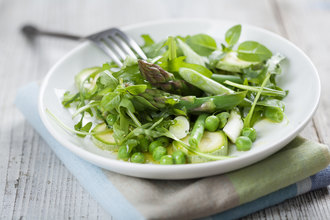Spring Veggies
Spring has sprung and so have our delicious spring vegetables. This time of year everything seems so fresh and new. Sweet and tender beginnings of the coming season of fresh local produce start with asparagus and baby spinach. Fresh herbs such as chives and mint also sprout in spring.
Nutritionally, asparagus and spinach are quite similar. Both are very low in calories, virtually fat free, high in fibre and good sources of vitamins A, K, C and folate as well as minerals such as potassium which helps lower blood pressure. They also contain phytochemicals which make these vegetables disease fighting as well.
1 serving= 6 spears asparagus or ½ c cooked spinach contain 20 kcals, 0.2g fat, 3g carbs and 130ug folate (about 1/3 daily value). Folate is an important B vitamin involved in cell division and DNA synthesis. Folate is also essential for pregnant women to prevent neural tube defects in newborns.
Asparagus
Asparagus contains anti-inflammatory phytochemicals such as saponins, quercetin, rutin and kaempferol. Chronic inflammation is a risk factor for Type II diabetes, heart disease and Alzheimer’s. Asparagus also contains the very potent antioxidant glutathione, known to have anti-cancer properties and contains a prebiotic carbohydrate; inulin, which is a fuel for the good bacteria in the large intestine.
When buying asparagus, look for crisp bright green stalks with firm compact tips. Store them with the stalk ends wrapped in wet paper towel in a plastic bag or trim the ends and place in a cup of water in the fridge. Trim or snap off the woody end of asparagus before cooking. Asparagus cooks very quickly, needing only about 3-5 minutes for steaming or sautéing. White asparagus is a milder tasting asparagus grown under the soil, preventing photosynthesis and thus colour production. Purple asparagus has a sweeter taste and contains less fibre.
Asparagus is delicious blanched on a vegetable platter, diced in an omelet, or as one of many vegetables in a stir fry or pasta sauce.
Interesting fact: Some people metabolize a derivative of the amino acid methionine in asparagus differently than others which causes the production of a smell in the urine.
Spinach
Spinach, once thought to be an excellent source of iron in the 1930’s, is not a great source of iron due to the high level of oxalates which bind it. However, it is a source of lutein, known for its’ protective effects against macular degeneration. When buying baby spinach, look for packages with loosely packed leaves that look dry and not crushed. Store them in the crisper for up to 2-3 days in a plastic bag and wash just before using. Lightly steaming spinach can make the iron and lutein more available for absorption.
Baby spinach is lovely raw in a salad or steamed as a side dish, but can also be sautéed and served with many dishes, often lending them the name “Florentine”.
Chives
Chives are a wonderful spring herb that flowers in June. They are part of the Allium species, used as an herb for seasoning and are one of the “fines herbes” of French cuisine along with chervil, tarragon, and parsley. Chives are often planted in flower beds and vegetable gardens to repel pests and attract bees with their flowers. The thin tubular leaves are milder in flavour whereas the larger ones have a strong sharp onion flavour. ½ c of chives contains only 20 kcal, although you would likely only have a tablespoon or so in a meal. They are sources of Vitamins A, C and K like other green vegetables and also contain folate and lutein. Chives are also a source of thio-sulfinites which are converted into the antioxidant allicin when chives are cut or crushed. Allicin reduces the production of cholesterol by the liver it also releases nitric oxide which causes vasodilation and helps reduce blood pressure. Allicin may also reduce the risk of stroke by reducing platelet aggregation.
Chives are delicious in sandwich fillings, on top of salads, potatoes, eggs, fish and pasta dishes.
Asparagus and pea salad with spinach and mint dressing (serves 4-6)
2 bunches asparagus, woody ends trimmed, halved diagonally
1 ½ cup baby peas (use frozen if fresh not available)
1/4c baby spinach leaves
2 Tbsp fresh mint leaves plus sprigs for garnish
1/4c lemon juice
3 Tbsp olive oil
1 tsp Dijon mustard
½ tsp sugar
- Bring a medium saucepan of water to boil over high heat. Add the asparagus and peas, and cook for 2 minutes or until bright green and tender crisp. Transfer to a bowl of ice water to stop the cooking process. Drain. Set aside in serving bowl.
- Bring a 2nd saucepan of water to a boil and quickly blanch spinach and mint leaves, cool in ice water, drain and squeeze out any water.
- In a small food processor, blend spinach, mint, lemon juice, oil, mustard and sugar. Season with salt and pepper.
- Toss asparagus and peas with the dressing. Serve and garnish with mint sprigs.















